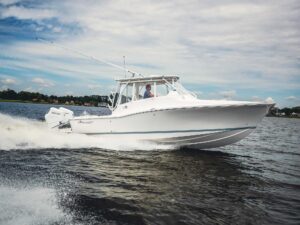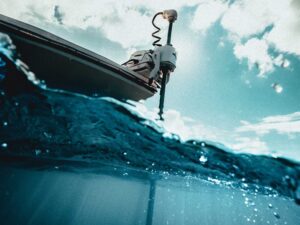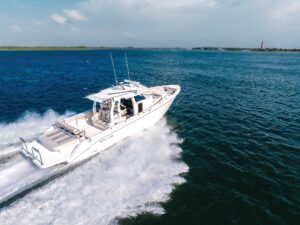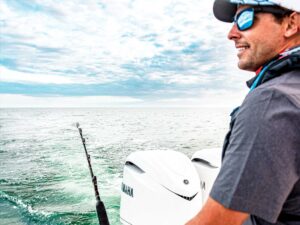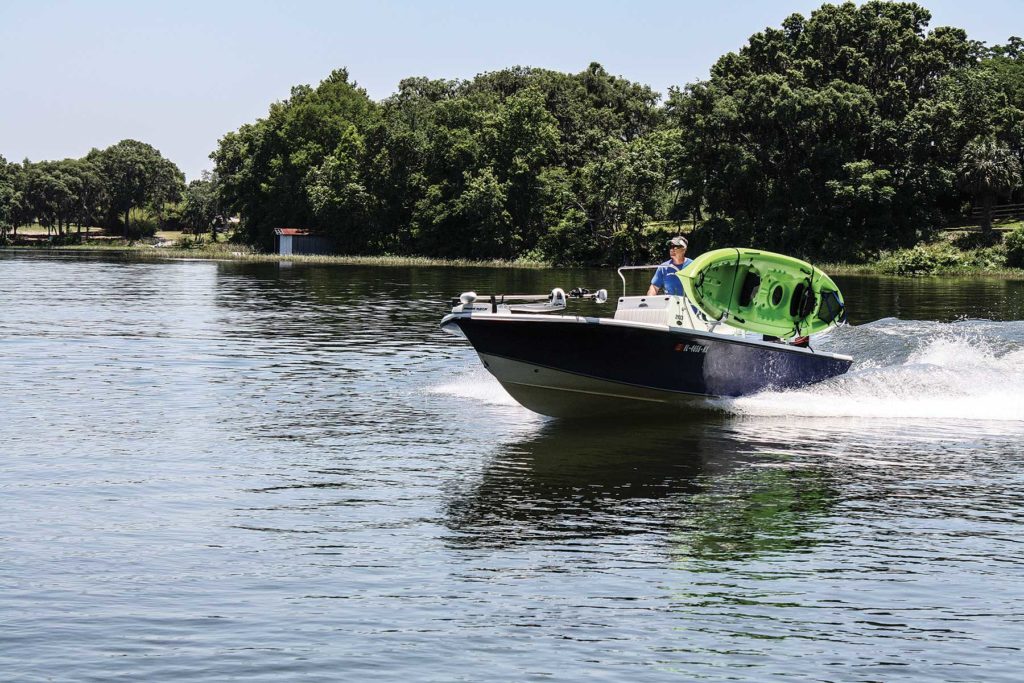
There are places your center console fishing boat can’t take you, like up a narrow meandering mangrove creek to cast for tarpon, into the middle of a dense kelp bed to target calico bass, over a barrier reef to reach rampaging trevally in a protected lagoon, across a remote flat in pursuit of bonefish, or into a wilderness no-motor zone where redfish abound.
However, your main boat might be able to get within paddling distance where you can anchor out, then launch a kayak or stand-up paddleboard (SUP). Such craft traverse the shallowest of waters, negotiate tight quarters and portage easily across bars to get you to the hot spots. These vessels are human-powered, so no-motor zones are, well, no problem.
But let’s face it: Paddle craft can be unwieldy when out of the water, and take up precious deck and seating space aboard your main ride. How do you carry and secure these on a fishing boat? Thankfully, quite a few systems let you easily stow and deploy ’yaks and SUPs.
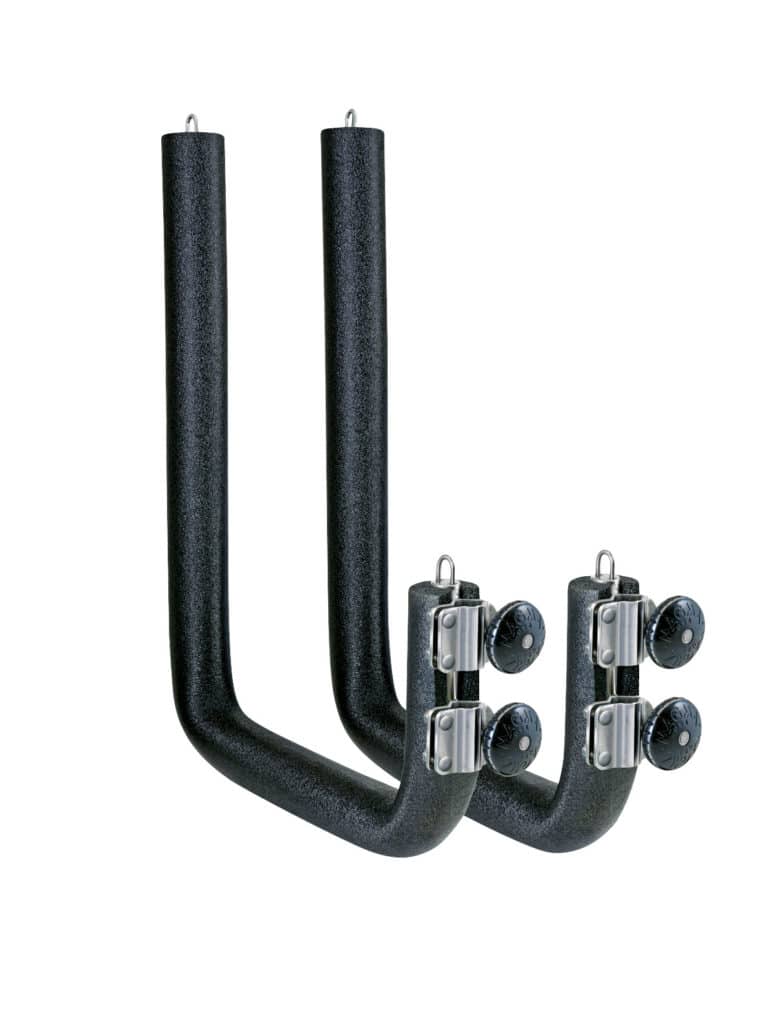
Rail Racks
Magma Products is perhaps best known for its line of marine grills, but it also offers the Removable Kayak/SUP rack (about $230), which includes two arms that clamp to vertical or diagonal bow-rail supports ranging from 7⁄8 to 1 1/2 inches in diameter.
The system is made from polished stainless steel with UV-resistant padding to protect paddle craft while cradled in the 1-inch arms. Each rack holds two SUPs or one kayak, with tie-down points on each arm to secure the craft with straps.
An exclusive quick-release-knob system allows each arm to be quickly removed or rotated inward when not in use, or swung in tighter to the bow rail to fit narrower kayaks or boards.
SurfStow’s Suprax (about $250) also clamps to a bow rail. The lightweight aluminum arms hold one SUP. EVA foam linings protect the board, and a built-in bungee cord secures it.
The Suprax universal clamp system swivels to attach to virtually any vertical or horizontal rails ranging from 7⁄8 to 1¼ inches in diameter. An add-on accessory arm (about $100) increases the capacity to a pair of SUPs.
In addition, SurfStow sells the Yakrax (about $300) rail-mount system for kayaks. It uses the same clamp system as Suprax, but the padded aluminum arms are wider to accommodate the greater hull depth of a ’yak.
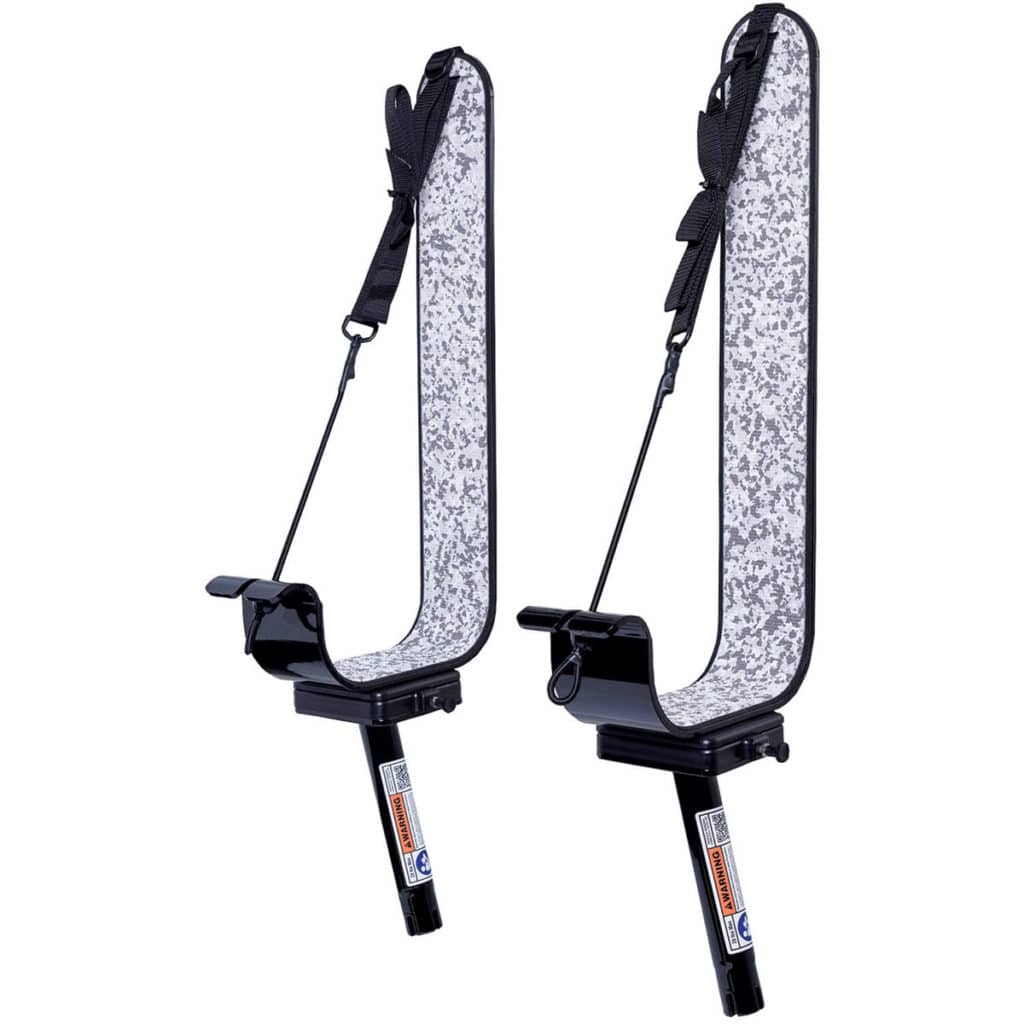
Rod-Holder Racks
For boats that don’t have high-profile rails, there are racks that cleverly fit in gunwale rod holders. Manta Racks’ stowage systems, for example, use gimbaled posts that fit inside the rod holders. A patented 360-degree locking swivel base allows boaters to angle each arm of the rack on a horizontal plane to suit the boat and board. Bases are available for both 15- and 30-degree gunwale rod holder tubes.
Manta Racks are constructed from quarter-inch aluminum, then powder-coated to resist corrosion. All hardware is stainless steel. SeaDek EVA foam on the inside of the arms offers cushioning. Built-in cords secure the board or ’yak.
Manta’s S1 rack (about $500) holds one board, while the S2 rack (about $800) holds up to two SUPs. The LTK (about $600) stows one kayak or one of the bigger new SUPs, such as the Dragonfly 13’6″ or Live Watersports L2 board.
StoreYourBoard.com‘s Outracker system (about $420) fits in gunwale rod holders, as well, but this rack is restricted to tubes with 30-degree angles. On the other hand, the two padded aluminum arms pivot and lock in a horizontal plane to fit different SUPs of varying depths. It accommodates up to two boards.
Another benefit of this system is that the post that drops in the rod tube extends upward to serve as a rod holder, so you can still stow rods or troll while also carrying paddle craft.
Remember that some boats also have gunwale rod holders across the transom bulkhead. That means these systems might also be used to carry paddle craft across the stern, as well as along each side.
Roof Racks
A hardtop offers a great horizontal surface for attaching accessories, including racks for kayaks and SUPs. Automobiles carry such gear, so why not boats?
Intrepid Powerboats specializes in creating custom features for its new-boat buyers, and models such as its 400 Cuddy are often built with custom-ordered hardtop racks for SUPs, says Joe Brenna, vice president of customer service. “Racks are installed as part of the build, as per the buyer’s – specifications,” Brenna says.
Inflatable Solution
Not all SUPS are solid. A growing number of models are inflatable, and that translates to easier stowage and portability aboard your boat. It also means you might be able to carry a much larger board than your boat would otherwise accept.
For instance, the Zeppelin (about $1,600) is a 12-foot-4-inch inflatable SUP from Bote that’s more than 3 feet wide, can carry two adults, and makes for a stable fishing platform. When deflated, however, it folds into a 45-pound backpack that can stow in a console or fish locker. The Zeppelin comes with a pump and a removable skeg.
Thanks to inflatable boards and yaks, clever rack systems and innovative boatbuilders, it’s easier than ever to carry paddle craft on your fishing boat, then use it as a floating base from which to launch ’yaks or SUPs to reach otherwise unreachable hot spots.
Launch Sequence
Depending on your boat’s gunwale or stern configurations, launching and boarding a kayak can be downright awkward. Here are three important tips from Sport Fishing Editor-in-Chief Doug Olander.
1. Bow or Stern First You might be tempted, particularly with two people, to pick up a kayak from each end, hold it away from the gunwale, and lower it to the water. But from even moderately high-freeboard boats, it’s easiest to simply slide the kayak bow or stern first (at 90 degrees to the gunwale). Be sure to first secure a dock line to the ‘yak to keep it from drifting away. Reverse this procedure when retrieving your kayak.
2. Board then Load Don’t try to put all your tackle and gear into a kayak before you launch, or some might slide off. Or your kayak might roll over as you are trying to sit down in it, and that will dump all of your precious tackle and expensive gear in the drink. A better plan: Have your gear on the boat’s deck. Then get in your kayak. Once you’re situated, have a crewmember hand your stuff to you, starting with the paddle.
Read Next: An Alaska Kayak-Fishing Adventure
3. Get Organized Just as with prepping a bigger boat at the dock before you depart, it’s good to spend some time boatside organizing your kayak before paddling away. Take 10 minutes or so making sure your handheld VHF is accessible, tethered and working; you have plenty of liquids; your life vest is on or handy; and your jaw gripper and pliers are secure, but available and within easy reach.

